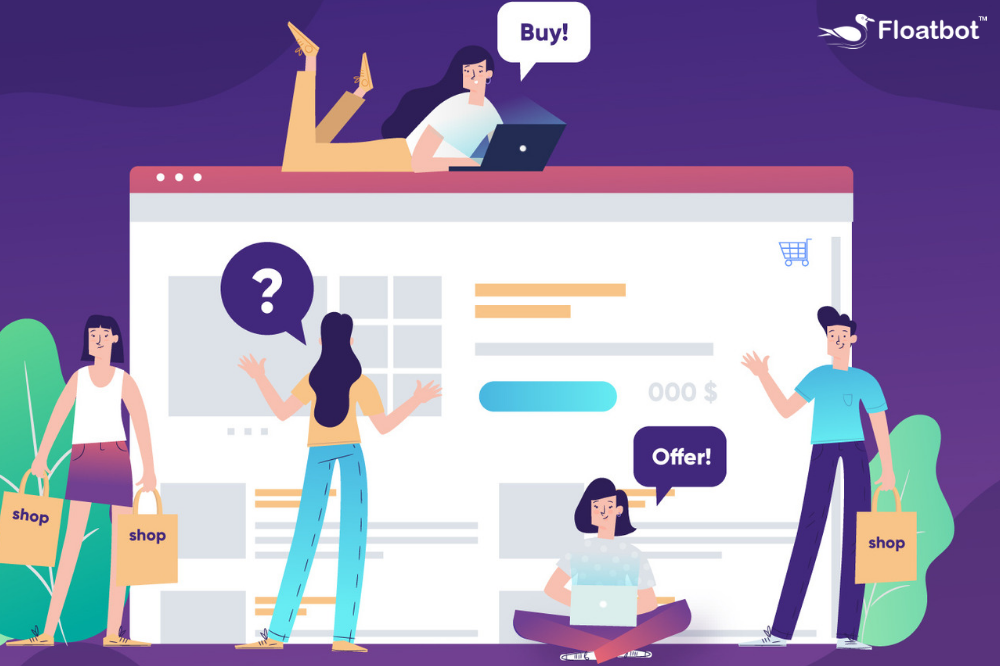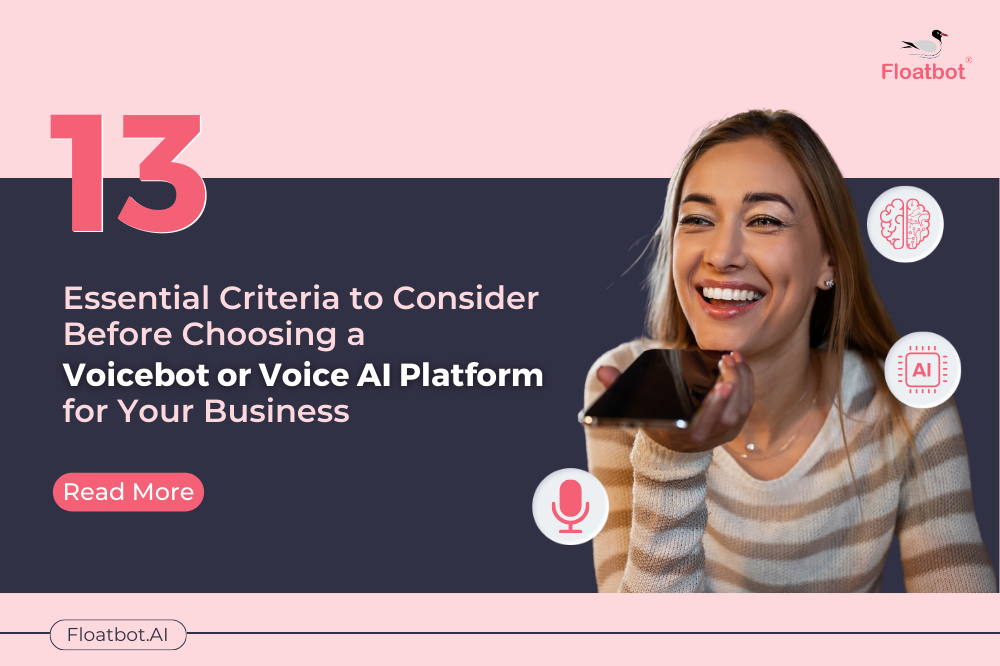Voicebot: An Ultimate Guide (Updated 2024)
Know everything about what is a voicebot (GenAI-Powered), its types, how it works & how a Voice AI Agents helps in a business automation with its use-cases.
- Jul 24 2024

Whenever you hear Voicebot, the first thing that comes to mind is Siri, Alexa, or OK Google. These are the most convenient voice-powered tools that have become a massive part of our day-to-day life. But these are not only AI-powered tools; voicebots have multiple use cases and can be implemented to improve customer service.
Voicebots now also commonly referred to as Voice AI Agents are smart and have ability to handle dynamic interactions too by providing personalized experience.
With the popularity of OpenAI’s ChatGPT, bots are not limited to pre-defined AI but enhanced with Generative AI. Now, we have LLM-driven Voicebots and chatbots for automation of various use-cases.
As per Voicebot market forecast 2024-2030, voicebot market size is estimated to reach $98.2 billion by 2027, growing at a CAGR of 18.6%. This shows increasing popularity of voicebots across the globe.
In this article, we will explore what are Voicebots or Voice AI Agents. How do they work? Voicebot use-cases and how Gen AI is empowering Voice conversations for CX.
Table of content
- What is Voicebot? or Voice AI Agents
- Types of Voicebots and their Use Cases.
- Generative AI-powered Voicebots
- Latency issue with Gen AI-powered Voicebots
- Benefits of Voicebot to business and customers.
- How do Voicebots work?
- Applications of Voicebot.
- Future of Voice Conversations with LLMs and Gen AI
What is Voice bot? or Voice AI Agents
A voice bot, also known as a conversational Voice AI Agent or voice assistant, is an advanced AI system that communicates with users through spoken language. Voice bots can be integrated into various applications, devices, and platforms, providing a convenient experience for users.
Voicebot operates using below technologies:
- Natural Language Understanding (NLU)
- Natural Language Processing (NLP)
- Machine learning
- ASR (automatic speech recognition)
- TTS (Text to Speech)
When the user speaks something, ASR converts the speech into text and the converted text is understood through NLP (natural language processing). Then the appropriate answer is formulated and converted into speech using Text to Speech (TTS) and the user gets an appropriate response for the query.
Voicebot understands user queries with the help of artificial intelligence and responds to the user. Voicebots have multiple benefits to customers and businesses; for instance, in contact centers, the user needs to go through interactive voice response(IVR) by pressing keys as per the instructions; unlike IVRs, the customers can talk in natural, human language with voicebots.
With time, the application of Voicebots is increasing - Voicebots are not limited to just virtual voice assistants, such as Alexa, Siri, or Google Assistants.
Some contact centers, for instance, have deployed Voicebots instead of human agents to converse with customers.
Types of voice bot
According to the application, voice bots can be bifurcated as below:
- Conversational Generative AI-powered Voicebot Integrated with Contact Center for Inbound and Outbound call automation
- WhatsApp Voicebot
- Chatbot with Voice AI
- Voice AI-based Smart assistants
Voicebot integrated with a contact center for Inbound and Outbound call automation
AI Voice bot integrated with the contact center uses AI-based 2-way conversational voice as a medium to communicate with the customer. It can automate inbound and outbound calls without any human intervention. It can also transfer the call to a human agent upon the customer’s request. Voicebot can be implemented as per the industry-specific use cases.
Use Cases of Inbound Calls
- Customer Support
- Sales Inquiries
- Customer Inquiries
- Employee IT Helpdesk
- Lead Qualification
- Customer Engagement
- Insurance Renewal
- Claims FNOL Insurance Filing
- Claim Status Enquiry
- Investigation & Verification
- Claim Settlement and More
Use Cases of Outbound Calls
- Automate Tele-Marketing Calls
- Payment & renewal reminder
- Debt collection
- Cross-sell and upsell
- Marketing automation
Nowadays, providing WhatsApp support has become mandatory for businesses; businesses want to connect through their favorite channels, and WhatsApp is one of them. And that can be easily achieved by implementing WhatsApp voicebot.
Whatsapp allows users to send voice inputs or voice commands to the bot. In reply, users can get text, voice, or both.
The Floatbot platform allows you to set user responses in text and voice. For instance, if the bot detects voice-based input, then the bot will answer with voice + text. You can also set it to a single response form, i.e., text or voice.
Chatbot with Voice AI
A chatbot with voice AI is a chatbot that can accept voice as input. The user can use the microphone option available to ask their queries, and the bot can reply in chat+/voice form as the user requires. Floatbot allows voice-based input with streaming. Along with voice, the bot also accepts text inputs. The benefit of a Chatbot is that it can act as an AI-based voice virtual assistant and give replies in a chat-based rich format and voice.
Voice AI-based Smart Assistants
AI-based, voice-based intelligent assistants work purely with voice. The response from this bot is always voice-based. Amazon Echo and Google Homes are examples of Voice AI-based Smart Assistants. Introducing voice AI-based assistants extended the reach of communication limited to mobile devices. The bot developed in the Floatbot platform can be integrated with intelligent assistants such as Amazon Echo and Google Home in real-time.
Generative AI-powered Voice bots
Checkout VoiceGPT (Generative AI) powered Voicebot below
Generative AI or LLMs is saving a lot of time for us, be it for content generation, seeking help for ideas, or any sort of help; LLMs have the potential to be our assistant and best friend to the rescue. The same applies to businesses; Gen AI helps businesses automate with ease. It understands user needs and interacts in a natural human-like language, personalizing each conversation.
When automating a voicebot using large language models, one must consider multiple factors such as latency, hallucinations, PII reaction, etc. Floatbot’s VoiceGPT is the most potent Voicebot technology powered by 100% Generative AI LLM models that are fine-tuned by Floatbot.AI
With Floatbot, you do not need to worry about latency, hallucinations, or other factors. Gen AI voicebots can be easily created with the Floatbot no/low-code platform, and outbound campaigns can also be scheduled and sent from the Floatbot platform.
Tackling Latency with Gen AI Voice Bots
With LLMs, the response latency is higher than other AI models. Increased latency leads to delayed response, which is not feasible for a voice call. Hence, latency needs to be decreased for LLM to respond quickly.
Here comes VoiceGPT in the picture; VoiceGPT is the most powerful Voicebot technology powered by 100% Generative AI LLM models that are fine-tuned by Floatbot.AI.
VoiceGPT responds in real-time on a phone call or real-time agent assists with low latency LLM and deep-tech architecture on inference.
Gen AI-powered bots allow users to interact in the most natural language and respond accurately. Gen AI bots are intelligent enough to understand user context and queries; no need to train bots for query variations.
How to build Voicebots?
Building a voicebot can be tedious when you are starting from scratch. You need to develop an NLP model, implement Automatic speech recognition (ASR), create text-to-speech capabilities (TTS), integrate with your backend system, write the code of handling all the different modules and on top of it you need to continuously monitor and improve it overtime to make the responses accurate.
Instead, you should opt for a No-code/low-code bot building platform such as Floatbot. Depending on your use-cases and requirements follow below steps to build a voicebot or Voice AI Agent for your business.
- Identify primary purpose and use-cases for your Voice AI Agent.
- Choose the right no-code/low-code platform that helps you build a smart and comprehensive GenAI powered voicebot.
- Design a conversational flow that includes greetings, questions, fallback options and more.
- Think on handling bot interruptions with appropriate query handling and correct responses based on the queries.
- Perform prompt engineering for GenAI model to perform and respond at its best.
- Define Guardrails for safety and security of your bot.
- Add PII redaction for elimination of personal identifiable information.
- Configure ASR to transcribe speech to text.
- Setup text-to-speech (TTS) to convert bot’s text responses into natural-sounding speech.
- Once your Voicebot is ready you can text and deploy it on your toll-free number, or you can also integrate with any CcaaS or CPaaS platforms. Floatbot’s native integration lets you launch voicebot within few minutes.
Watch our webinar to learn how you can build GenAI Voicebot and launch it within 30 minutes.
Whar are voicebot benefits to Businesses and Customers?
While seeking support from a business, a customer’s preferred mode of communication is a phone call. Call automation with a Voice bot eliminates language barriers and is supported on any smart device. Voicebots can be operated with the most straightforward phone with any network connection. Voicebots are easy to interact with, even for the older generation.
Benefits to a Business
Improved customer service: A voicebot is available 24/7, providing around-the-clock support; hence, customers get instant assistance anytime.
Cost savings: Voicebots automate repetitive tasks and reduce the need for human agents for routine inquiries and support. In addition, Voicebots can handle multiple queries at a time, which a human agent cannot do.
Improved customer experience: With instant support and 24x7 availability, voicebots are proven to improve customer experience.
Multilingual capabilities: Voicebots support multiple languages, enabling businesses to provide multilingual support.
Personalized support and reminders: Businesses can address customers’ concerns and send personalized reminders with the help of a voicebot.
Accessibility: Voicebots make services more accessible, especially for people with disabilities who find it easier to interact through voice commands.
Benefits to Customers
Instant response: Customers get instant resolution to their queries and need not wait for a human agent to respond.
Reduced waiting time: As voicebot provides instant support, customers don’t need to wait for the answers.
Reduced frustration: Quick and accurate responses from voice bots help reduce customer frustration, especially when dealing with routine and straightforward queries.
Personalized interactions: Bots, in general, can remember customer preferences, which provides a personalized experience.
Convenient communication: Voicebots understand natural language, making it easy for customers to interact in natural language. Voicebot makes it easy for customers and businesses to interact and provide correct information.
HOW DO VOICEBOTS WORK?
Voicebots operate through a combination of various deep tech modules that include
Speech to text
The Speech Text or ASR (Automatic speech recognition) module converts the natural speech (audio spoken by the user) to text; it works fine even in noisy environments. The Speech to Text module is typically developed with end-to-end deep learning-based speech recognition. It can recognize and understand different accents and languages.
NLP Engine
Once the spoken words are transcribed, the voicebot utilizes NLP to understand the meaning behind the words. NLP (Natural language processing) helps the system interpret and comprehend the user's intent, allowing it to respond appropriately.
Intent detection/LLMs
After the query is processed, intent gets detected, or the query is passed to LLMs for execution. Voicebots are trained to work on use-case-specific queries, and intent detection takes place when a query is encountered, or either query is passed to LLMs for execution.
Integration with backend systems
Voicebots are often integrated with backend systems or databases to fetch real-time information or perform specific tasks. This integration allows them to provide up-to-date and relevant responses.
APPLICATIONS OF VOICE BOT
Voicebots can become very useful for businesses across all industries as they can save the time required for customer service. Below are the industry-specific use cases in which voicebot can be implemented.
Banking
- Automated banking services
Before proceeding with the bank, a customer must get all the information related to banking services, such as loans, cheques, cards, etc., that can be provided over a voicebot called banking automation bot.
- Customer support with intelligent assistants
If a user wants support over a call, then a voicebot automates the call and provides the desired response for the query; this would eliminate human support, saving time and money.
- Improved security with voice biometrics
With the latest AI tech, getting voice authentication over a call is possible for security reasons. A Voice AI Agent created using Floatbot’s platform allows adding voice biometrics that make a voicebot safe and secure for banking purposes.
- Improved customer interactions with native languages
The multilingual capabilities of a voice bot enable users to interact in native languages. This makes customer interaction smooth and comfortable with a bot.
Insurance
- Automated sales journey
A voicebot can replace a traditional way of filling out an insurance policy form in a more interactive manner that helps a user save time filling out a lengthy list of questions for a policy. With the more accessible and interactive approach, the sales journey becomes more robust, resulting in more conversations through a voicebot.
- Automated claims FNOL process.
With the traditional approach for the FNOL process, a customer calls the insurance company and talks to their agent, and provides all the information; if the agents are busy, then the customer needs to wait. Meanwhile, with the voicebox, there is no waiting time for the customers, and for the company, it becomes an automated process, saving the costs and time of their agents.
- Customer support
An emergency can occur at a time in the insurance sector, and a voicebot is an AI automation tool. Hence, it is available 24/7 for customers to answer their queries anytime. It answers the queries and connects to a human agent when required.
- Lead generation
Generating leads is a tedious and endless task for a sales team; if they adopt the power of artificial intelligence by implementing a voice bot, this task can become smoother and more interactive. Whenever a salesperson calls a prospect, either the prospect is uninterested or will not take the call seriously. But if a voicebot calls the prospect, it grabs their attention, and a prospect would like to know more about the call and the offer.
TO WRAP UP
With the development of Artificial Intelligence, voicebots will play a crucial role in the automation of various essential areas for a business. The primary trend we will see in coming years is the combination of voice and chat as one conversational AI tool for automation.
If you want to adopt the power of AI voicebot for your business, check out Floatbot’s voicebot products and solutions. Floatbot provides a no-code, SaaS-based Voice AI platform that helps you build and deploy AI-powered voicebots and Chatbots without coding. We also provide deep-tech ASR and Voice Biometrics solutions.
To know more, please contact us at connect@floatbot.ai, and our team of experts will connect with you.






